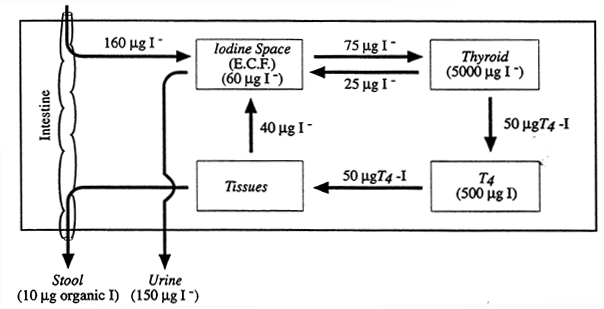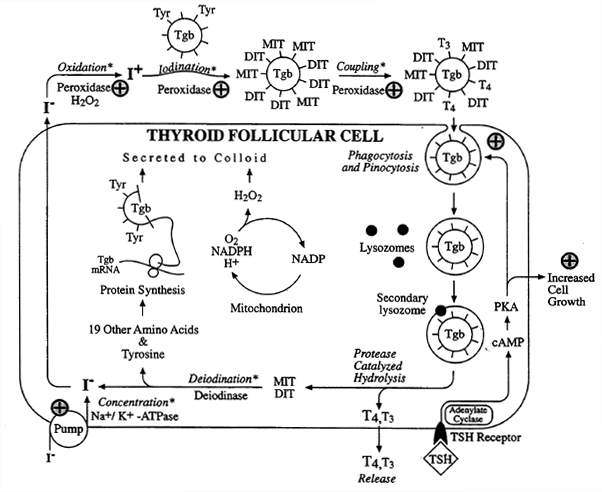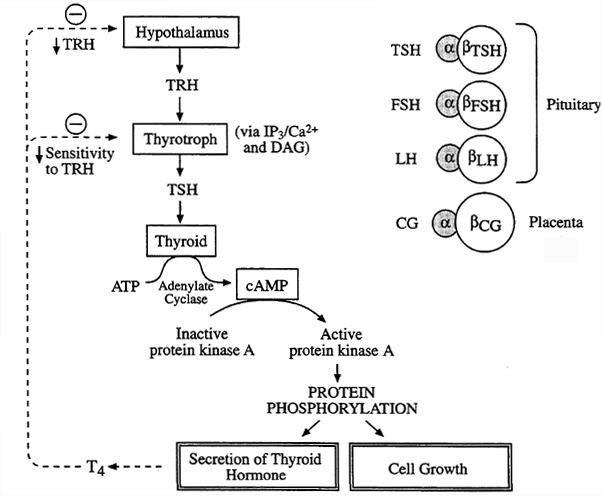
The Thyroid Hormone System
Hyperthyroidism:
Is usually due to the excessive production of the thyroid hormones (T4 and T3) by the thyroid gland.
There are many causes for hyperthyroidism, the most well known disease is Graves disease.
Clinical Correlate-
Graves Disease: results from the autoimmune production of thyroid stimulating IgG (TSI) which activates the thyroid stimulating hormone (TSH) receptor on the thyroid follicle cells.
Results: diffuse enlargement of the thyroid and excessive, uncontrolled production of T4 and T3 (due to lack of feedback regulation by TSI).
Symptoms: rapid heart rate, nervousness, inability to sleep, weight loss, weakness, excessive sweating, sensitivity to heat, red moist skin, and ophthalmic disorders (protruding...).
Treatment Options:
1. block hormone production with an antithyroid drug
2. destroy the thyroid gland with a radioactive isotope of iodine (131I) or a combination of these methods.
Hypothyroidism:
Insufficient amounts of free T3 and T4.
Causes: thyroid failure, diseases of the pituitary or hypothalamus.
Symptoms: slow heart rate, lowered systolic blood pressure but high diastolic pressure (due to fluid retention), sluggish behavior, sleepiness, sensitivity to cold, dry skin and hair, obesity.
Treatment: thyroid hormone replacement.
The Thyroid Hormones:

Iodine:
The crucial element and the key to the thyroid hormones.
Since there is little naturally occuring iodine in the body and we don't ingest much from the diet, the thyroid gland can both concentrate iodine and make thyroid hormone.
Iodine from the diet is generally converted to iodide and absorbed by the gut.
Note: 90% of the bodies iodine is present in the thyroid, primarily as T4.
Iodine Metabolism and Balance in Humans:

Synthesis of the Thyroid Hormones:


Tgb: thyroglobulin
i) iodide enters the thyroid by a pump linked to the Na+ / K+-ATPase
ii) hydrogen peroxide converts iodide into ("active") iodide I+
Regulation of T4 Release:iii) iodination of Tyr produces MIT and DIT
iv) MIT and DIT are stored in the thyroglobulin
v) when thyroglobulin is cleaved by a protease, the MIT and DIT are deiodinated and the iodine recycled
vi) T4 and T3 are released to the blood
vii) Tyr and thyroglobulin are recycled
TRH: Thyrotropin Releasing Hormone
TSH: Thyroid Stimulating Hormone
FSH: Follicle Stimulating Hormone
LH: Leutinizing Hormone (peaks at ~ 24 Hrs prior to Ovualtion, used in over the counter "Ovulation" Test Kits)
CG: Chorionic Gonadotropin Hormone (used in Pregnancy Test Kits)

Note: TSH, FSH, LH, CG all have identical a-subunits and unique b-subunits and all work through Gs receptor mechanisms.
T4 Feedback Regulation:1) T4 inhibits TRH release from the hypothalamus
2) T4 inhibits TSH release from the pituitary by limiting the sensitivity of the pituitary to TRH stimulation
Clinical Correlate: Goiter (enlargement of the thyroid)
There are two types of Goiter, hypo- and hyper-thyroid.
"Hypothyroid" Goiter-
a) nutritional lack of iodine impairs T4 biosynthesis and serum levels fall
b) this breaks the feedback by T4 at the hypothalamus and pituitary ----> XS TSH secretion
c) TSH stimulates thyroid growth ----> elicits goiter
"Hyperthyroid" Goiter-
XS TSH is produced due to a pituitary or hypothalmic tumor OR
presence in the serum of a "long acting thyroid stimulator" ----> stimulates TSH binding ---->
thyroid growth and T4 release
Biological Effects and Mechanism of Action of Thyroid Hormones:

The Principal Function of the Thyroid Hormones- "spark" for the oxidative reactions and regulation of metabolic rates in the body
T3 is ten times more active than T4
T3 also acts two to three times faster than T4
T3 is the tissue active form of the thyroid hormone
© Dr. Noel Sturm 2019